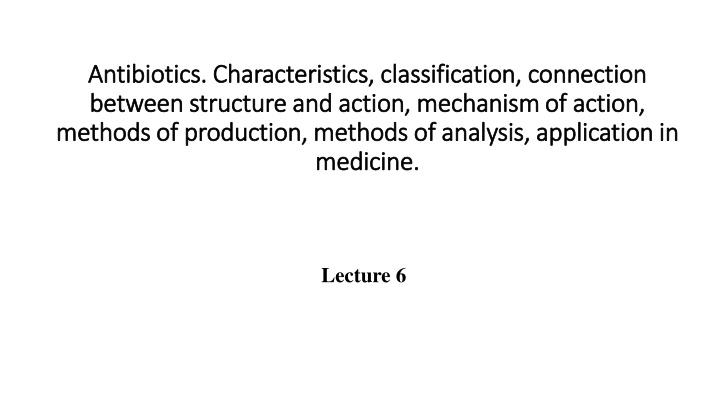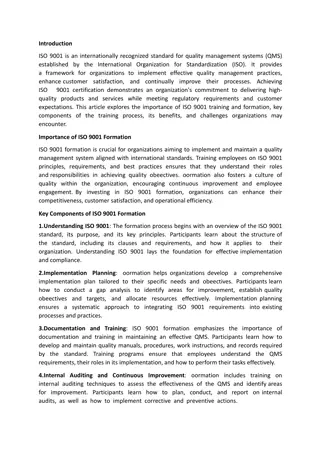
Antibiotics: Characteristics, Classification, and Mechanism of Action
Explore the world of antibiotics, from their characteristics and classification based on structure and action methods to their application in medicine. Learn about the various types of antibiotics, their mechanisms of action, and production methods.
Download Presentation

Please find below an Image/Link to download the presentation.
The content on the website is provided AS IS for your information and personal use only. It may not be sold, licensed, or shared on other websites without obtaining consent from the author. If you encounter any issues during the download, it is possible that the publisher has removed the file from their server.
You are allowed to download the files provided on this website for personal or commercial use, subject to the condition that they are used lawfully. All files are the property of their respective owners.
The content on the website is provided AS IS for your information and personal use only. It may not be sold, licensed, or shared on other websites without obtaining consent from the author.
E N D
Presentation Transcript
Antibiotics Antibiotics. . Characteristics Characteristics, , classification between between structure structure and and action methods methods of of production production, , methods classification, , connection action, , mechanism mechanismof of action methods of of analysis analysis, , application medicine medicine. . connection action, , application in in Lecture 6
ANTIBIOTICS Antibiotics (Greek anti vs. bios - life) - products of life (or their synthetic analogues and homologues) of living cells (bacterial, fungal, plant and animal origin), which selectively inhibit the functioning of other cells - microorganisms, tumors, etc. This group includes hundreds of drugs of different chemical structure, differing in spectrum and mechanism of action, side effects and indications for use. The term "A." suggested ZA Waxman (1942). Classification: natural (penicillins, lincomycin, vancomycin and others). semi-synthetic (products of modification of natural molecules: Classification by mechanism of action: inhibitors of cell wall synthesis of microorganisms ( -lactams, vancomycin); A. that disrupt the molecular organization and function of cell membranes (polymyxins, antifungals, aminoglycosides, and cyclic lipopeptides); Inhibitors of protein and nucleic acid inhibition are inhibitors of protein synthesis at the level of ribosomes (chloramphenicols, tetracyclines, macrolides, lincosamides, aminoglycosides, and oxazolidinones). RNA polymerase inhibitors (ansomacrolides). amoxicillin, clindamycin, cefazolin, etc.).
Classification by chemical structure: -lactams (penicillins, cephalosporins, carbapenems, monobactams); aminoglycosides; macrolides (erythromycin, clarithromycin, roxithromycin, azithromycin, chloramphenicols; tetracyclines; lincosamides (lincomycin, clindamycin); fusidic acid; ansamacrolides (rifampicin); polymyxins; polyenes (nystatin, levorin, amphotericin B), etc. Classification by spectrum of antimicrobial action: A., which act mainly on gram-positive and gram-negative cocci and corynebacteria,clostridia; A., active against gram-positive and gram-negative bacteria; A. with predominant activity against gram-negative bacteria; anti-tuberculosis A .; antifungal A. spiramycin, josamycin, midecamycin); gram-positive rods -
Tetracyclines Tetracycline In medical practice it is used in the form of a base or hydrochloride. Mechanism of action. Associated with impaired protein synthesis in the bacterial cell. Once in the bacterial cell, the antibiotic prevents the formation of a complex of transport RNA with the ribosome, thus stopping protein synthesis. Properties. Yellow crystalline powder, odorless, bitter in taste. Very poorly soluble in water and alcohol. Hygroscopic. Stable in solutions of weak acids, decomposes in solutions of strong acids and alkalis. Identification. TLC. When adding H2SO4 - purple color, which when adding FeCl3 turns red brown. Quantitative definition. HPLC method. Storage. In a tightly closed container, in a dark place at room temperature. Application. Antibacterial (bacteriostatic) agent, the spectrum of antimicrobial action is wide. The antimicrobial activity of the drug is manifested against most grams of positive and gram-negative bacteria, including to leptospira, rickettsiae, as well as to spirochetes and major viruses.
Oxytetracycline Mechanism of action. Associated with impaired protein synthesis in the bacterial cell. Properties. Yellow crystalline powder, slightly soluble in water, sparingly soluble in ethanol, insoluble in chloroform and ether. Hygroscopic. Identification. IR spectrum, TLC. Reaction with H2SO4 (conc.) - purple-red color. Reaction with FeCl3 - brown color. Quantitative definition. TLC method. Storage. In a tightly closed container at a temperature of 10-20 C. Application. Antibacterial (bacteriostatic) agent.
Doxycycline hydrochloride Mechanism of action. Associated with impaired protein synthesis in the bacterial cell. Properties. Yellow crystalline powder. Hygroscopic. Easily soluble in water, methanol, moderately soluble in 96% ethanol, practically insoluble in ether. Identification. TLC. Reaction with H2SO4 (conc.) - yellow color. Reaction to chlorides. Quantitative definition. Liquid chromatography method. Storage. In a well-sealed container that prevents light. Application. Antibacterial (bacteriostatic) agent. Highly effective in infections of the upper respiratory tract (bronchitis, pleurisy, pneumonia), has a prolonged effect.
Metacycline hydrochloride Mechanism of action. Associated with impaired protein synthesis in the bacterial cell. Properties. Yellow crystalline powder, odorless, bitter in taste. Slowly soluble in water. Application. Antibacterial (bacteriostatic) agent. Treatment of bronchitis, pneumonia, pleurisy, dysentery, whooping cough, sore throat, scarlet fever, brucellosis, tularemia, typhus and recurrent typhus, urinary tract infections, chronic cholecystitis, purulent meningitis, skin and soft tissue infections (phlegmo, phlegmon, ablution, prostatitis, syphilis, purulent complications of surgery, etc.
Chloramphenicols Chloramphenicol Mechanism of action. The action is associated with a violation of the process of protein synthesis in the microbial cell at the stage of transfer of amino acids of tRNA to ribosomes. Synthesis.
Properties. White odorless crystals with a yellowish tinge, bitter in taste, slightly soluble in water, easily soluble in alcohol. Identification. T. pl., IR, UV spectrum, TLC. Hydrolysis reaction:
It arises first (formation of acinitroform). Confirm the presencechlorides. The reaction of formation of azo dye red: yellow color, what to pass in red-orange
In the express analysis - the reaction with CuSO4 in an alkaline environment in presence N-butanol - the alcohol layer turns blue- violet: Quantitative definition. Nitritometry after preliminary reduction of the nitro group, s = 1:
Liquid chromatography method. Cupriodometry, direct titration, indicator - murexide, s = 2. Argentometry or mercurimetry, s = . Photocolorimetry on the formation of azo dye after recovery nitro groups with further diazotization and azo combination. Iodometry. The method is based on the oxidation of alkaline products hydrolysis of chloramphenicol, s =1/3. Storage. In a well-sealed container, in dark glass cups. Application. A broad-spectrum antibiotic used to treat dysentery, pneumonia, whooping cough, typhoid fever, etc.
Storage. In a well-sealed container, in dark glass cups. Application. Chloramphenicol stearate is used in pediatric practice - it has no bitter taste. Side effects. Chloramphenicols disrupt the function of blood-forming organs, so treatment with these drugs requires a blood test. Can cause dysbacteriosis.
Penicillins Benzylpenicillin sodium (potassium) salt Mechanism of action. Penicillins block the synthesis of peptidoglycan (a biopolymer that is a major component of the bacterial cell wall). All parasites have a bactericidal effect due to the death of bacteria. Ampicillin sodium salt
Synthesis. Properties. Penicillins are white crystalline substances with a bitter taste. Sodium and potassium salts of P. are easily or very easily soluble in water, hardly in organic solvents, and are often hygroscopic. Free acids, novocaine salt of benzylpenicillin - sparingly soluble in water and easily - in organic solvents. Identification. IR, UV spectrum, TLC. Reaction with formaldehyde in the presence of H2SO4 (conc.) - characteristic color Substances (salts) give reactions to Na+, K+, novocaine. Non-pharmacopoeial reactions: reaction of formation of copper (II) (green) or iron (III) (red color) of hydroxamates after hydroxylaminolysis of -lactam cycle:
Cephalosporins Cephalosporins - beta-lactam antibiotics, the chemical structure of which is based on 7-aminocephalosporic acid (7-ACC). First isolated in 1948 from the fungus Cephalosporium aeromonium. Discoverer cephalosporins - Giuseppe Brotzu (1895-1976), Italian pharmacologist and politician Cefazolin sodium salt Mechanism of action. Associated with damage to the cell membrane of bacteria that divide, due to the specific inhibition of enzymes that are penicillin-binding proteins (PPB). Synthesis.
Properties. White, sometimes with a yellowish tinge powders. Slightly soluble in water (except Na + -salts), sparingly soluble in alcohol. Some have a characteristic odor and are sensitive to the world. Identification. IR, UV spectrum, TLC. Reaction with formaldehyde in the presence of H2SO4 (conc.) - characteristic color. On+-salts give appropriate reactions to the sodium cation. The presence of -lactam cycle - the reaction of formation of hydroxamates of Cu (II) or Fe (III):
Quantitative definition. Liquid chromatography method. Chemical methods (similar to penicillins). Biological methods. Physico-chemical methods (spectrophotometry, photocolorimetry). Storage. In a dry, dark place. Application. Cephalosporins have a broader spectrum of action than penicillins and less toxicity. The difference in the structure of penicillins and C. determines the resistance of C. to staphylococcal penicillinase and greater resistance to acids. Therefore, cystic fibrosis is prescribed for the treatment of penicillin-resistant infections. C. is used in acute and chronic diseases of the respiratory organs, urinary tract, and genitals; with postoperative and other infections.
Quantitative definition. Liquid chromatography method. Chemical methods (similar to penicillins). Biological methods. Physico-chemical methods (spectrophotometry, photocolorimetry). Storage. In a dry, dark place. Application. Cephalosporins have a broader spectrum of action than penicillins and less toxicity. The difference in the structure of penicillins and C. determines the resistance of C. to staphylococcal penicillinase and greater resistance to acids. Therefore, cystic fibrosis is prescribed for the treatment of penicillin-resistant infections. C. is used in acute and chronic diseases of the respiratory organs, urinary tract, and genitals; with postoperative and other infections.
Carbopenems A class of -lactam antibiotics having in its structure a -lactam ring not directly linked to a thiazolidine ring: Mechanism of action.Like all -lactam antibiotics, it is a violation of microbial cell synthesis at the time of mitosis. But at the same time K. has certain peculiarities. K. penetrates the microbial cell much better and faster than other -lactam antibiotics. K. have a wide range of therapeutic effects, are well tolerated, and are low- toxic drugs. Extremely wide spectrum of action of K., low level of resistance to them of microorganisms give the chance to apply them in the mode of antibacterial monotherapy, including at heavy infections in intensive care units.
Imipenem Imipenem has been used in clinical practice since 1980 and was developed by the pharmaceutical company Merck Sharp & Dohme, (MSD). Properties. Powder from white or almost white to light yellow. Application. Indicated for severe, multidrug-resistant infections (mostly nosocomial) and mixed infections; in cases of primary therapy preceding the identification of the pathogen; bone and joint infections; abdominal infections and gynecological infections, sepsis and septic endocarditis, complicated infections of the genitourinary system, infections of the skin and soft tissues, infections of the lower respiratory tract.
Aminoglycosides antibiotics Aminoglycosides - a group of natural and semi-synthetic antibiotics, the molecule of which includes aminosaccharides, which are connected by a glycosidic bond with an aglycone fragment - hexose. Mechanism of action. Penetrating into the cells of microorganisms, aminoglycosides disrupt protein synthesis in two ways - disrupt the initiation of synthesis by binding to the 30S subunit of the ribosome and disrupt the process of reading information from RNA, leading to premature termination of translation and premature detachment of the ribosomal complex. synthesized protein.
Streptomycin sulfate The discoverer of streptomycin (1944) - Zelman Abraham Waxman (1888 - 1973), Nobel Laureate (1952). Properties. White (almost white) powder. Hygroscopic, very soluble in water, practically insoluble in ethanol and ether. Identification. TLC. Maltol test: in an alkaline medium C. maltol; + FeCl3 -purplecolor:
Reaction to sulfates: SO42 + Ba2 + = BaSO4 Quantitative definition. Microbiological method (HFC). Photocolorimetry, which is based on the use of maltol sample. Storage. In a dry place, taking into account hygroscopicity. Application. In the treatment of tuberculosis, pneumonia, peritonitis, gonorrhea, brucellosis.
Kanamycin monosulfate Properties. Powders of white or almost white color, hygroscopic, soluble in Identification. TLC. Reaction to the aliphatic amino group of kanamycin with ninhydrin. Reaction to sulfates. Quantitative definition. Microbiological method. Polarimetry (gentamicin sulfate). Storage. In an airtight container, in a dark place. Application. More wide spectrum heterocyclic structure. For the treatment of diseases of the gastrointestinal tract, tuberculosis, infectious skin diseases, sepsis, urinary tract. antibacterial actions, than antibiotics
Lincosamides Lincosamides- a class of antibiotics, which includes the natural antibiotic lincomycin and its semi- synthetic analogue clindamycin. Lincomycin hydrochloride Mechanism of action. Inhibit the synthesis of microbial cell proteins by binding 50S subunits of ribosomes, inhibiting the incorporation of transport RNA into ribosome-mRNA complexes. As a result, a bacteriostatic effect develops. Application. Treatment of severe infections caused by lincomycin-sensitive strains of streptococci, pneumococci and staphylococci. The use of this drug should be limited to patients with penicillin allergy or other patients for whose treatment, in the opinion of the doctor, the use of penicillin is inappropriate.
Polyene antibiotics of glycoside structure Nystatin Mechanism of action. Binds to the sterol cell membrane of fungi, as a result of which the membrane becomes unable to function as a selective barrier, leading to the loss of major components of the cell. Application. Treatment of diseases caused by fungi of the genus Candida (Candida albicans, etc.), candidiasis of the mucous membranes of the mouth, skin and digestive tract.
Antamycin antibiotics At the heart of the structure is an aromatic nucleus connected to a macrocyclic aliphatic chain called an anza chain. The aliphatic chain does not contain lactone bonds characteristic of macrolide antibiotics and is attached to the nucleus by an amide N-atom Rifampicin Mechanism of action. Is to inhibit DNA-dependent RNA polymerase, which inhibits transcription. Application. A wide range of action is combined with high efficiency. Prescribed in cases where other antibiotics are ineffective. For the treatment of all forms of tuberculosis, gastrointestinal lesions and purulent infections.
Antitumor antibiotics ntitumor antibioticsused in medical practice: derivatives of halo acid (olivomycin); anthracycline derivatives (rubomycin); quinoline-3,5-dione derivatives (bruneomycin). Olivomycin
Rubomycin Bruneomycin Mechanism of action. The fact is that they create stable complexes of DNA cells, which leads to disruption of DNA-dependent RNA synthesis. Analysis. It is based on the use of physical, physico-chemical, chemical methods.


















